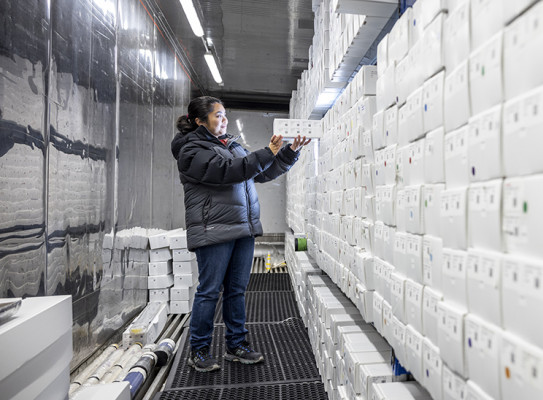Core Analysis Laboratory

The Core Analysis Laboratory specialises in the preparation, sampling, and scanning of soft sediment cores.
Sedimentary cores are archives of Earth’s history, and can tell us a lot about environmental and climate change, the timing and impacts of natural hazard events, and the impacts of human interactions with the natural environment.
Our laboratory provides specialised equipment for the preparation and sampling of soft sediment cores, obtained from lakes, swamps, harbours, estuaries and oceans. These samples are curated, logged, sampled and analysed with our hyperspectral scanner.
The data and analytics we generate are combined with biophysical and social sciences expertise, and with mātauranga Māori knowledge, to build a comprehensive picture of the environmental history from the core collection site.
This knowledge helps us forecast future changes to New Zealand’s natural environment, so that scientists, working together with government, iwi, community partners and stakeholders, can implement practical and timely solutions to protect and restore these areas.
Our Expertise
Our Core Analysis Laboratory team are skilled in the following processes of soft sediment cores:
- Splitting cores, using our Geotek core splitter
- Logging the stratigraphy of sedimentary layers within the cores
- Sterile and no sterile core sampling for fossil content, radiocarbon dating, chemical analysis, eDNA analysis
- Hyperspectral scanning of cores and post-processing of the core scan information
Our Equipment
- Geotek core splitter(external link), capable of splitting cores of up to 150 cm
- SPECIM (SisuSCS single core scanner)(external link) scanner with VNIR hyperspectral camera, able to produce high-resolution images and used to generate reflectance spectral indices from which we can infer metrics of environmental change such as in-lake primary productivity. The SPECIM hyperspectral core scanner is currently the only one in the Southern Hemisphere used for environmental change scientific research.
Put an image of the core splitter and another image of the HS scanner here, could be side by side.
Our Clients
Current national projects that work on the analysis of soft sediment cores, and use our facility, include Lakes380 (external link) and the Lake Ohau Climate History Project.
Our Location
The Core Analysis Laboratory is located in the DEXA building at NIC, Gracefield.
-
Did you know
Sediment from lakes, swamps, harbours and estuaries are laid down year-by-year and can span tens, hundreds to thousands of years. Layers preserved in sediment cores are like pages of a history book that record environmental change, weather events, vegetation changes and human impacts. Everything that happens in or around the lake leaves a trace in the sediment and this can be studied to extend our knowledge over centuries.
Some Glacial lakes in the South Island of Aotearoa New Zealand contain annually layered sediment that span the past ~17,000 years. Sediment cores recovered from these lakes (e.g., Lake Ohau) are being used to explore the causes of climate change and variability in extreme climate/flood events over the past several millennia.